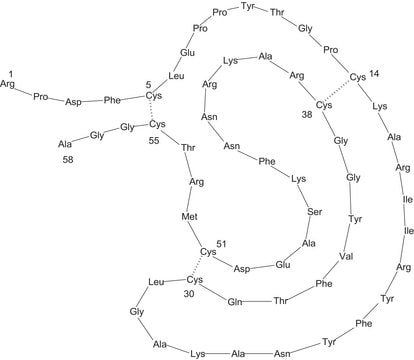RK-13 Cell Line from rabbit
21715, rabbit kidney, Epithelial-like
Synonim(y):
GL RK/13 Cells, Glaxo Laboratories Rabbit Kidney 13 Cells, R13 Cells
Zaloguj sięWyświetlanie cen organizacyjnych i kontraktowych
About This Item
Kod UNSPSC:
41106514
eCl@ss:
32190102
Polecane produkty
product name
RK-13 Cell Line from rabbit, rabbit kidney, 00021715
pochodzenie biologiczne
rabbit kidney
tryb wzrostu
Adherent
kariotyp
2n=44, stem-line = 56 (=22%)
morfologia
Epithelial-like
produkty
Not specified
receptory
Not specified
metody
cell culture | mammalian: suitable
Warunki transportu
dry ice
temp. przechowywania
−196°C
Pochodzenie linii komórkowej
Rabbit kidney
Opis linii komórkowej
RK13 has been derived from kidney cells of a 5 week old rabbit. The cell line has been shown to be susceptible to pseudorabies virus, rabbitpox virus, myxomatose virus, vaccinia and EAV. Sensitivity to other viruses such as Simian adenovirus and rubella has been reported as well with the production of cytopathic effect (CPE). RK13 has been successfully treated with thiamutin for eradication of mycoplasma. The Bovine Viral Diarrhoea Virus (BVDV) status of this cell line was previously described as negative. Results of recent multiple molecular tests for BVDV that were undertaken by two independent testing laboratories were equivocal. This means that we cannot confirm the BVDV status of this cell line.
Zastosowanie
Virus studies
pożywka hodowlana
Rutyna subkultury
Split sub-confluent cultures (70-80%) 1:4 using 0.25% trypsin or trypsin/EDTA; 5% CO2; 37ºC; monolayer is confluent after 48-56 hrs and stable for at least 21d; small syncytia in elder cultures are typical.
Inne uwagi
Additional freight & handling charges may be applicable for Asia-Pacific shipments. Please check with your local Customer Service representative for more information.
This page may contain text that has been machine translated.
Certyfikaty analizy (CoA)
Poszukaj Certyfikaty analizy (CoA), wpisując numer partii/serii produktów. Numery serii i partii można znaleźć na etykiecie produktu po słowach „seria” lub „partia”.
Masz już ten produkt?
Dokumenty związane z niedawno zakupionymi produktami zostały zamieszczone w Bibliotece dokumentów.
Nasz zespół naukowców ma doświadczenie we wszystkich obszarach badań, w tym w naukach przyrodniczych, materiałoznawstwie, syntezie chemicznej, chromatografii, analityce i wielu innych dziedzinach.
Skontaktuj się z zespołem ds. pomocy technicznej





